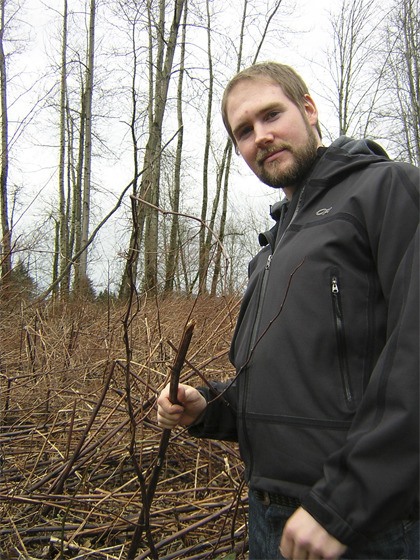Acres of tangled thorns have made a lifeless mat where ferns and native shrubs once grew along Fall City’s Snoqualmie River shoreline.
Noxious plant invaders, including Japanese knotweed and Himalayan blackberry, have spread over five acres in Fall City Park.
But volunteers and employees of the Snoqualmie Tribe are taking the land back, using a federal grant program and working with King County Parks, Fall City Park District and the Puget Sound Partnership to restore native plant habitat.
Exploring the site, Matt Baerwalde, water quality manager for the Snoqualmie Tribe, explained that removing invasive plant species helps improve the health of the watershed, aiding fish and all animals who use the riparian habitat.
Invaders spread quickly but do little to stop erosion or provide year-round habitat.
“Nothing can grow in there except blackberries,” Baerwalde said. “When these trees die and fall down, there won’t be any other trees.”
Removing the berries is a big job, because the invader is tough.
A burly, bladed weed cutter slices up the canes, but underneath is a thick, stagnant litter of dead canes and roots. The root balls have to be dug up, otherwise, the plant comes back.
Near the park’s historic hop shed, weed-block fabric shows how the finished project will look. Native plants grow out of holes cut in the fabric. Once a thriving canopy is established, an understory of ground plants will be introduced. A shady, green layer will prevent invaders from coming back.
Eliminating knotweed is even more challenging. Workers will have to hand-inject each plant with herbicide to kill it. If a small, live piece falls off and escapes notice, it could sprout a new knotweed plant.
The restoration project also includes an interpretive trail with signs about the species and their cultural significance to the Snoqualmie Tribe.
The park’s vicinity was a traditional camp for the tribe, and the Snoqualmies desire a continuing presence in the area, said Neal Jander, GIS technician with the tribe’s environmental department.
According to Jander, it’ll take about five years of maintenance to establish native plants at the site.
The Tribe has recently applied for funding to continue the project downstream. Phase two will include nine more acres of restored habitat and will continue the trail and interpretive signage.
Baerwalde and Jander cautioned Valley residents about other invaders.
They have noticed species such as English laurel and icy encroaching in local forests.
“They have really sweet berries that wildlife love,” he said. “They’re really attractive, but they end up spreading like crazy,” displacing native species that belong here.
Help plant
Volunteers are welcome to help at the first native planting event, 10 a.m. to 2 p.m. Saturday, Feb. 20. To take part or get directions, e-mail tribal cultural coordinator Adam Osbekoff at adam@snoqualmienation.com or call the Snoqualmie Tribe’s Environmental and Natural Resources Department at (425) 292-0249.



